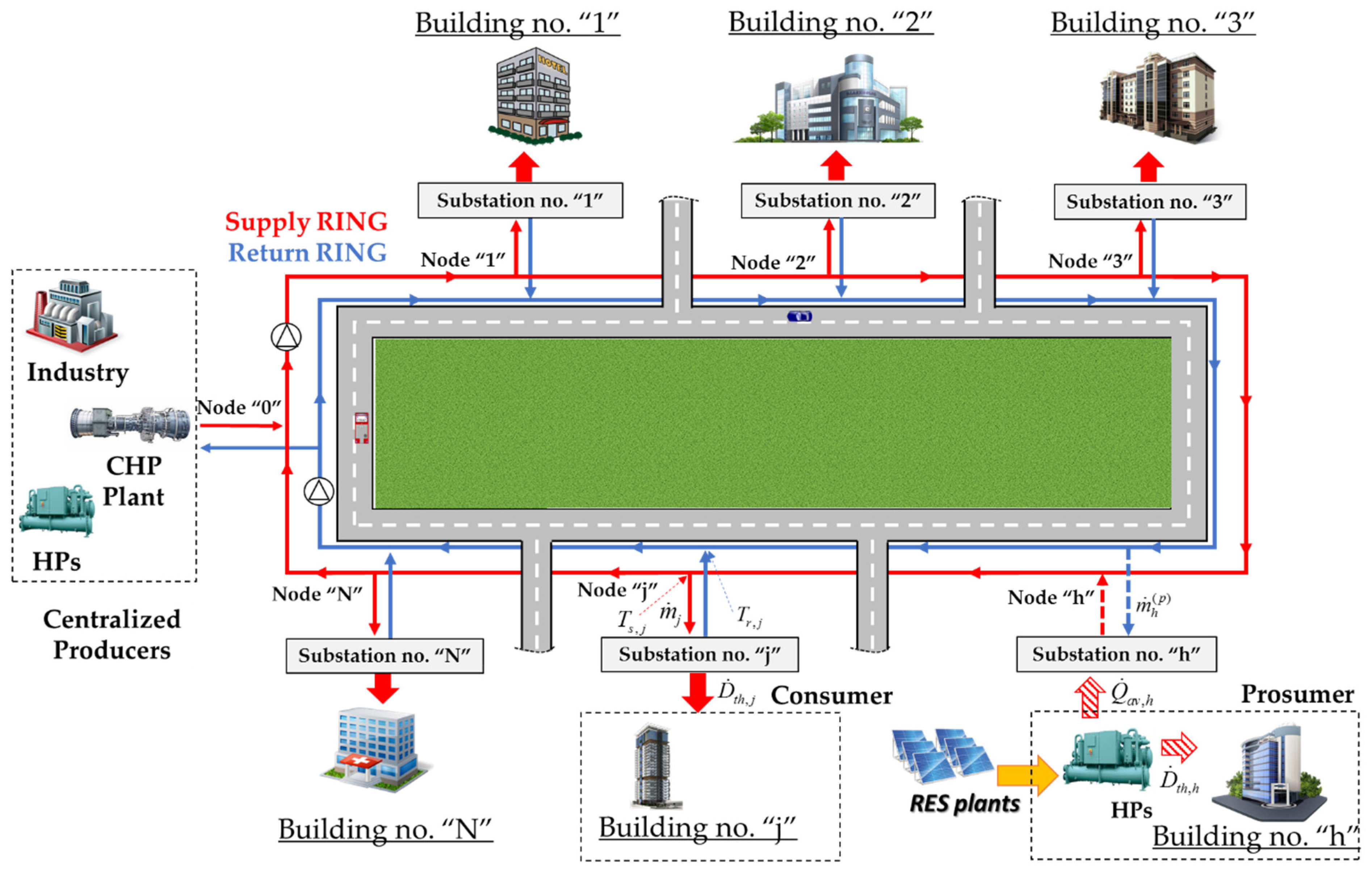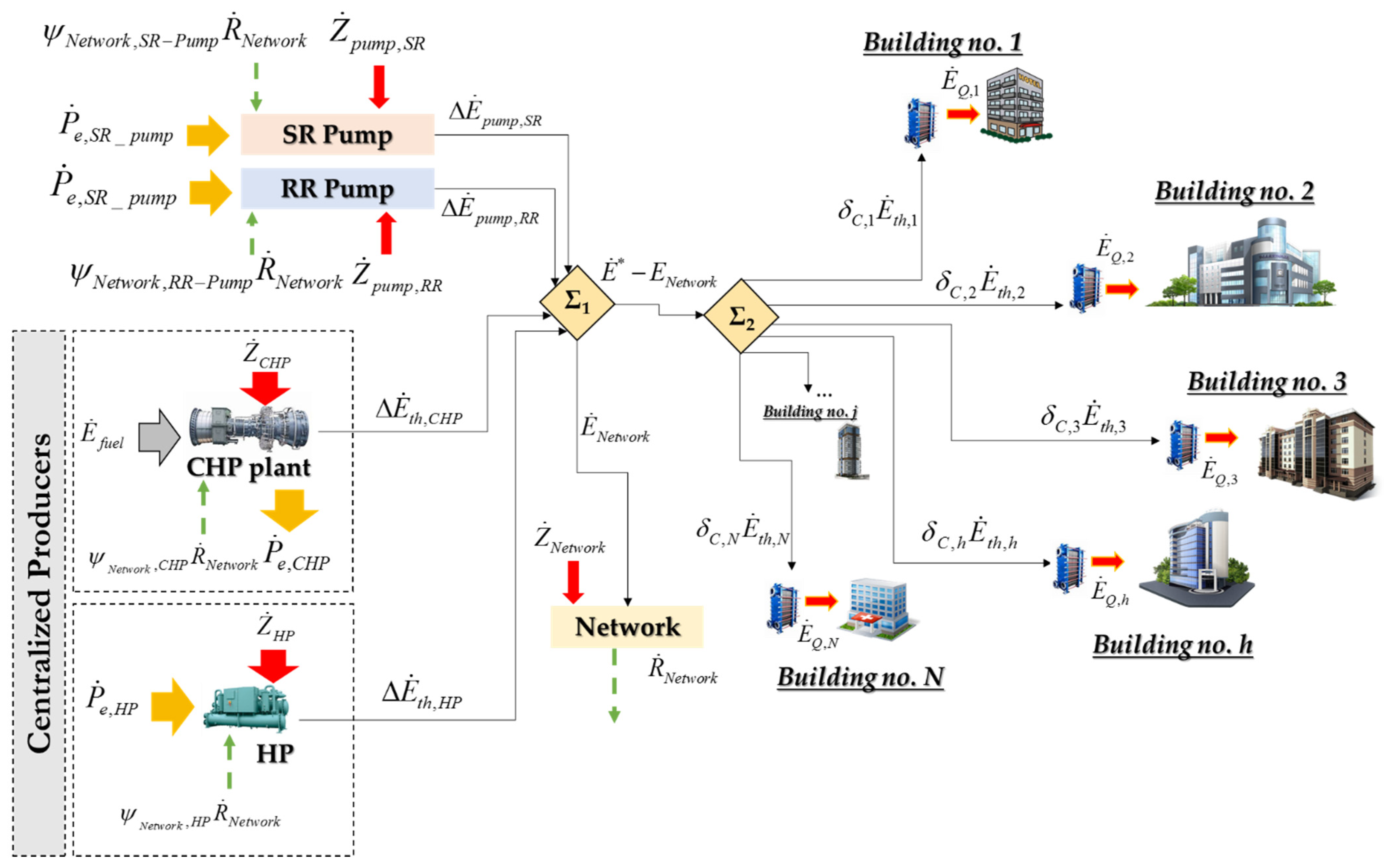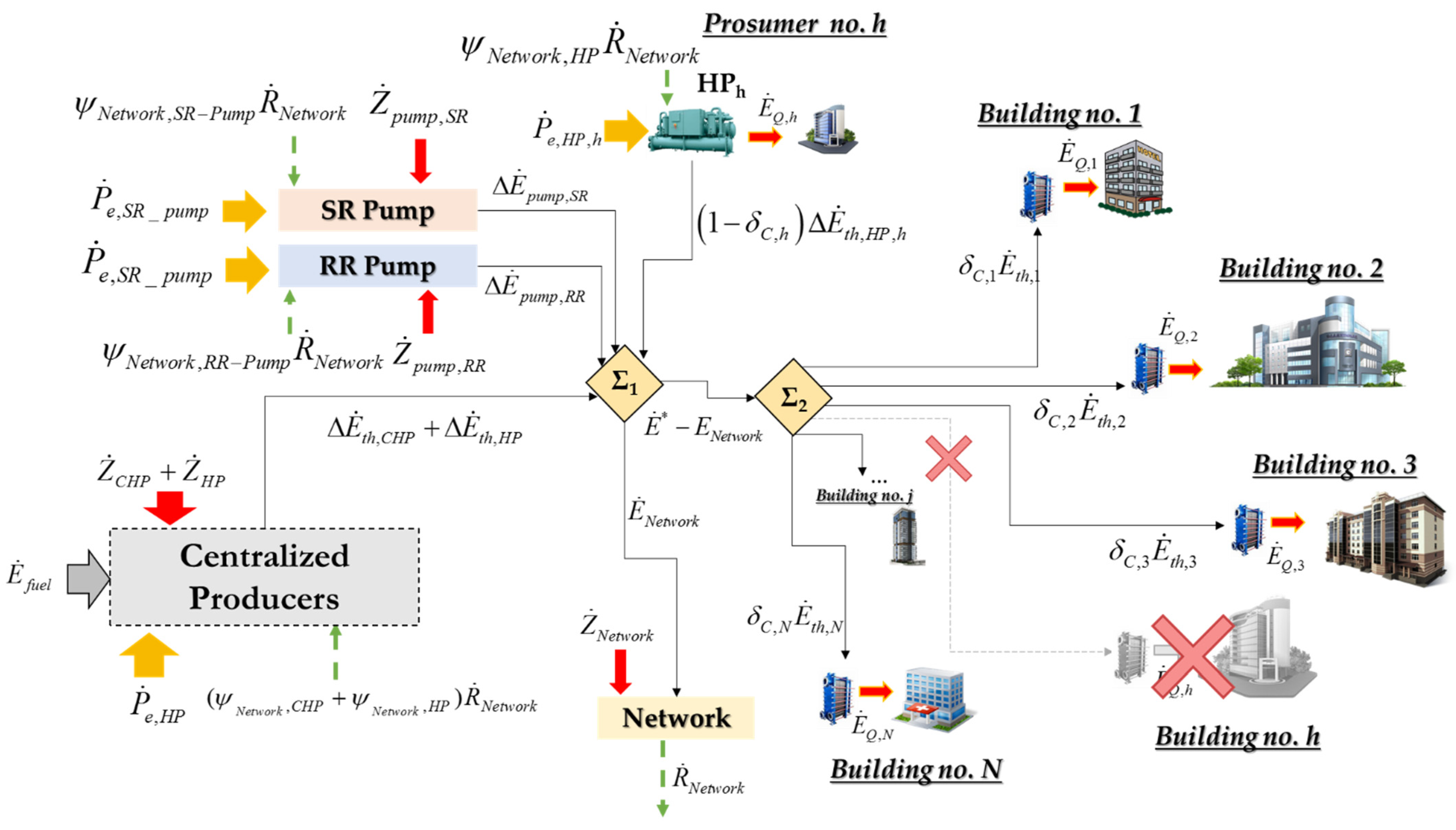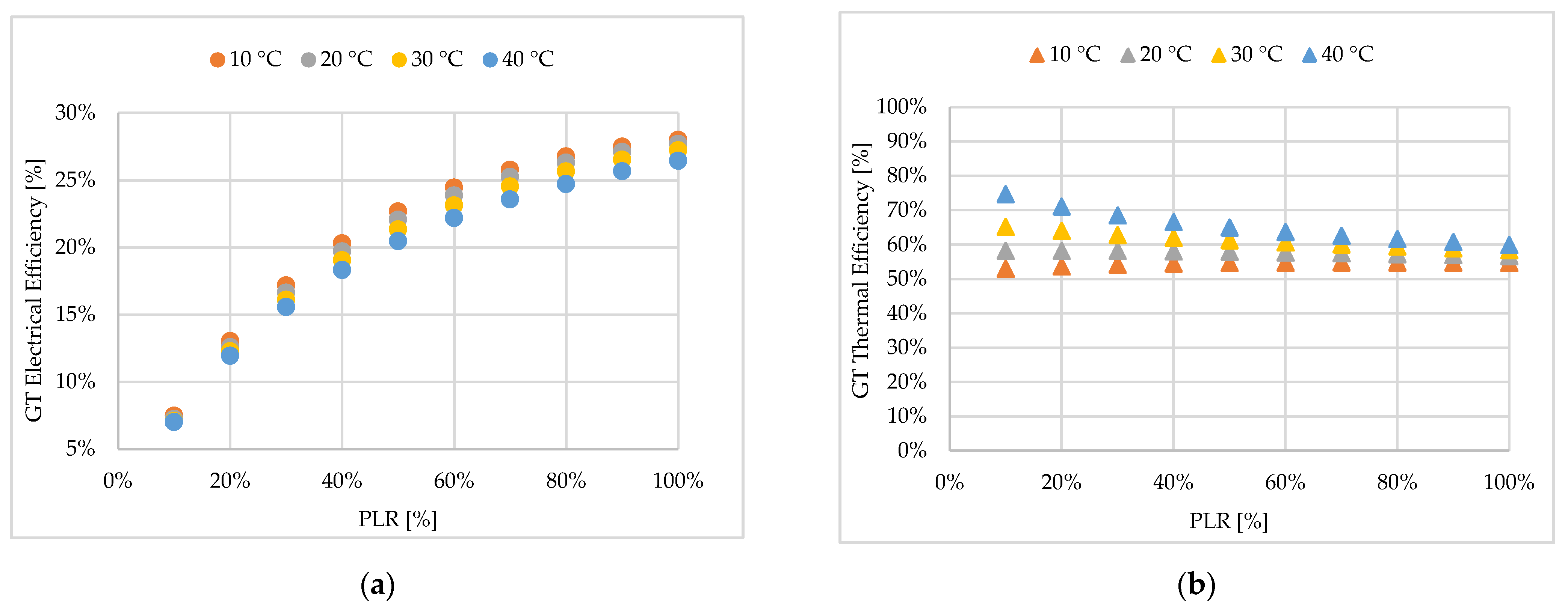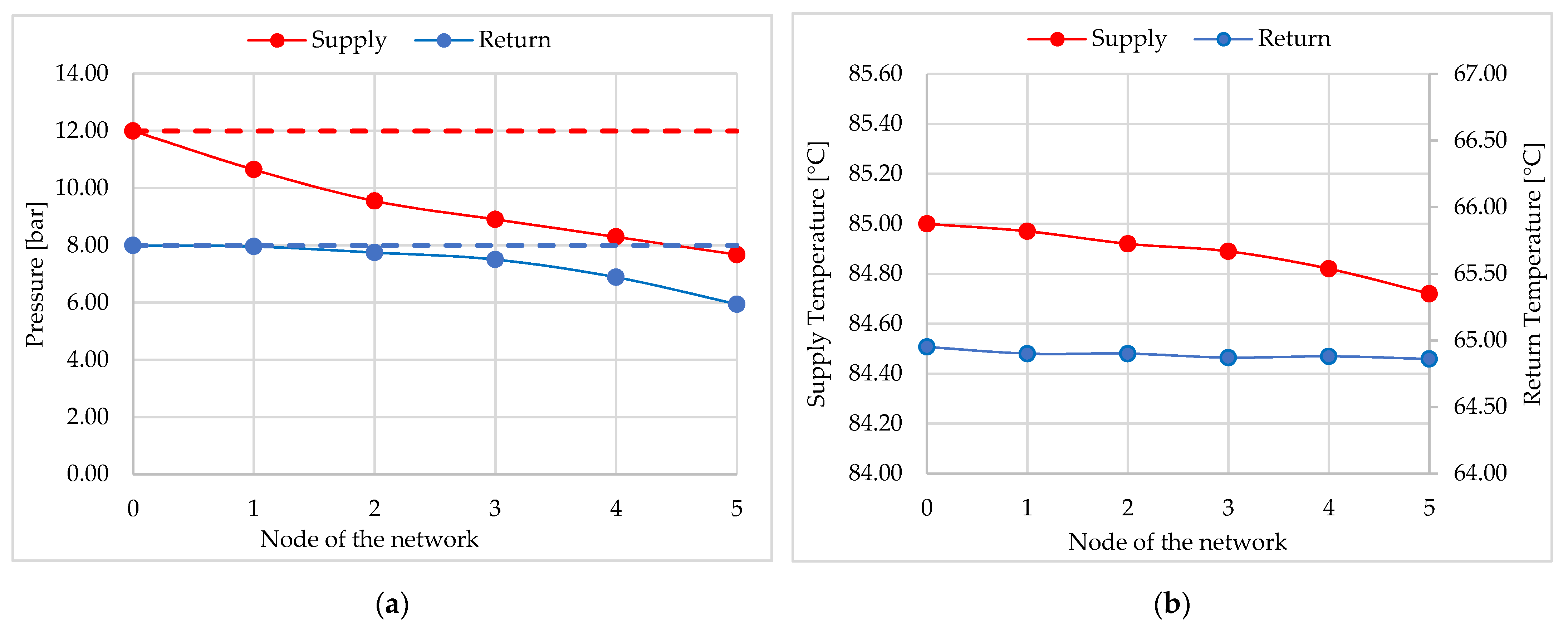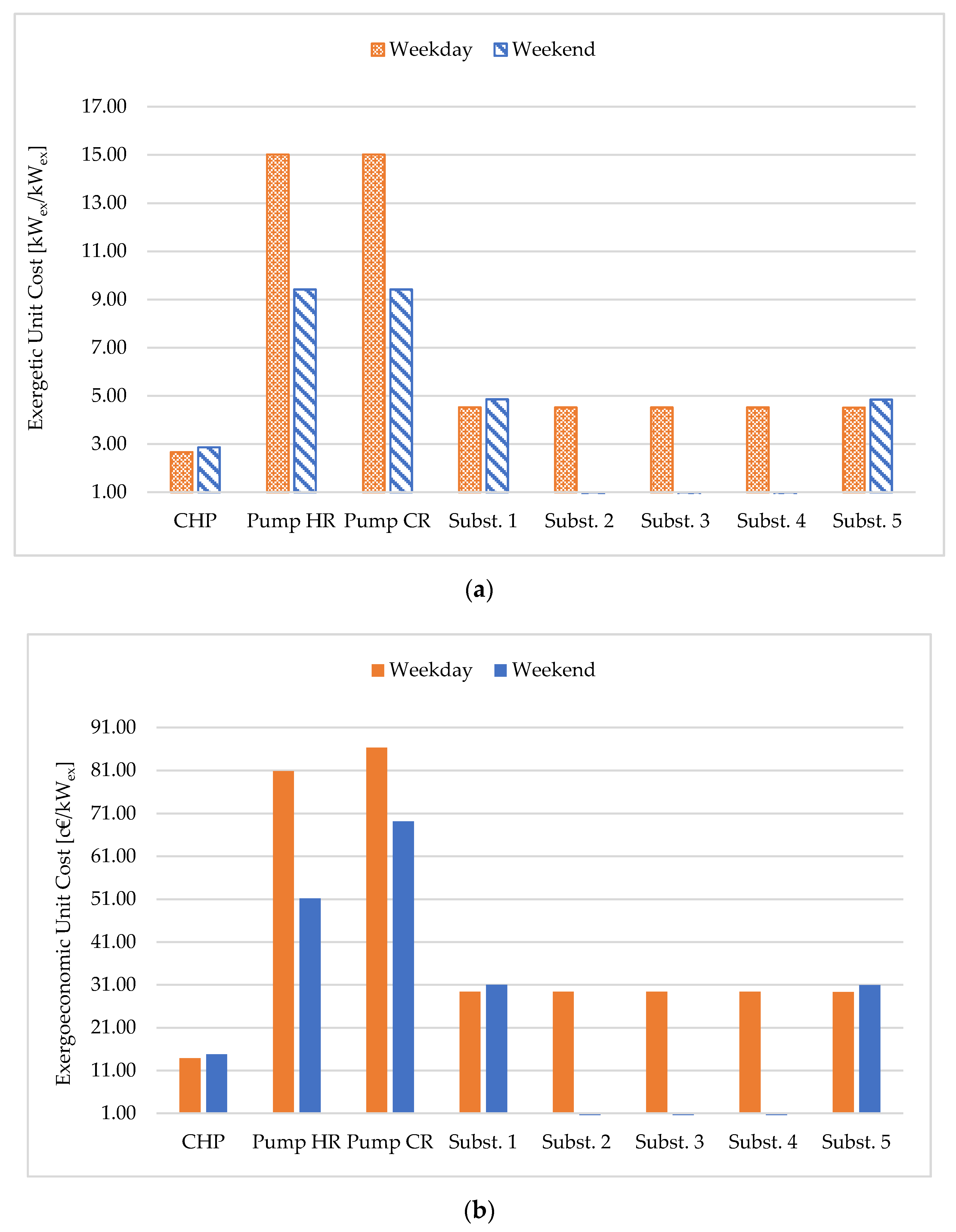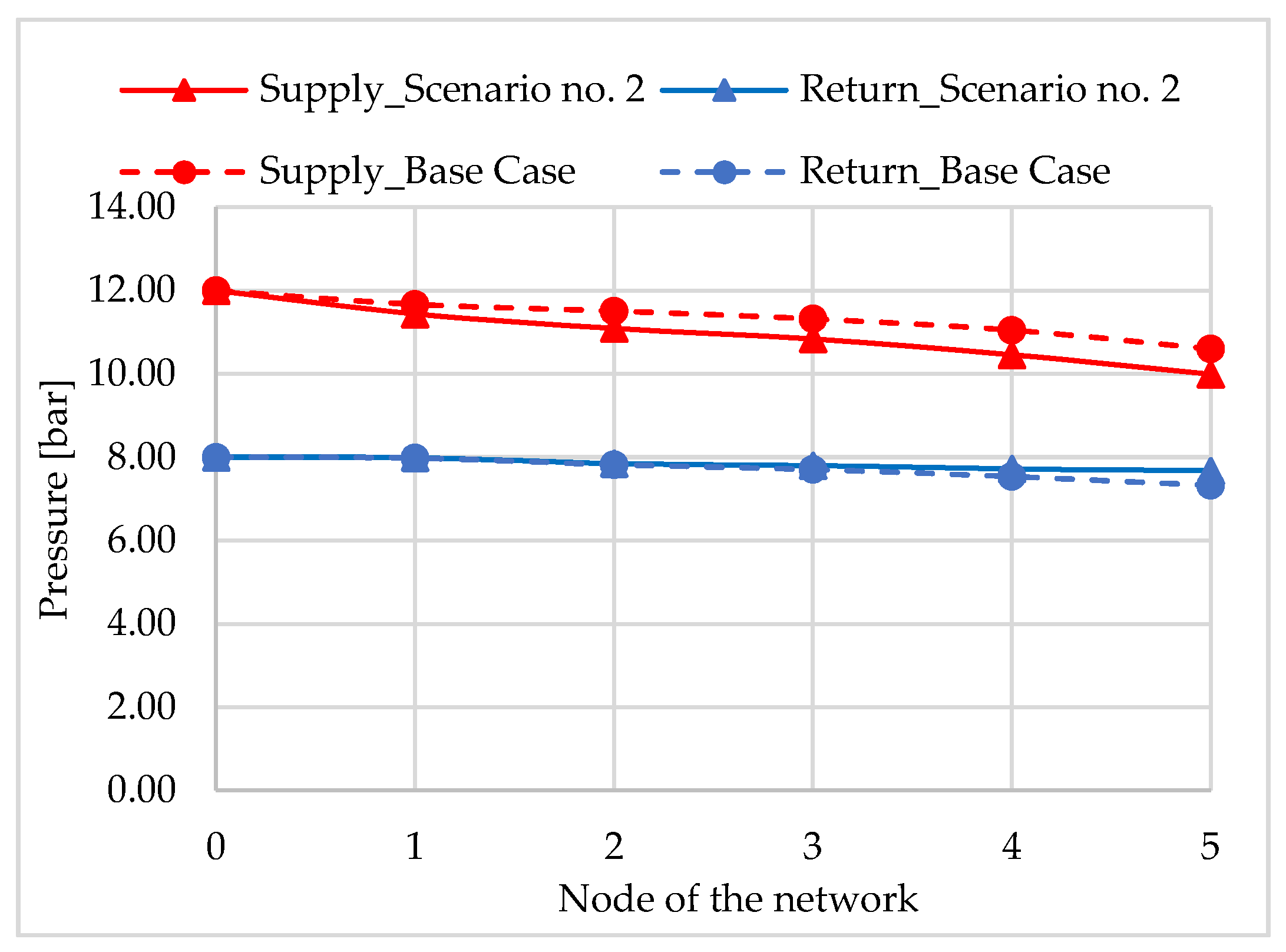1. Introduction
It is estimated that in the European Union (EU), space heating accounts for nearly 64% of final energy consumption in the residential sector [
1]. The adoption of energy-saving measures and the exploitation of renewable energy sources (RES) are the main routes for reducing the environmental impacts of this sector [
2]. Among the available technologies, district heating and cooling (DHC) networks are well-established systems that satisfy the thermal demands of buildings efficiently and reliably [
3].
District Heating (DH) networks are widely adopted in Northern, Central, and Eastern Europe [
4]. Fahl et al. [
5] estimated that in Europe DH covers about 25% of residential heating demand. Nowadays, DH systems consist of centralized power stations that supply pressurized hot water or steam via pipes to urban areas [
4]. Such systems are characterized by significant heat losses, and they could not allow for the integration of low-temperature heat coming from renewable energies sources or industrial processes [
3]. Typical heat sources to DH systems are Combined Heat and Power (CHP) plants, fueled via fossil fuel, municipal waste [
6], or biomasses [
7]. Colmenar-Santos et al. [
8] projected that the use of waste heat available from power plants for supplying DH networks in the EU would lead to a primary energy saving of about 15%. Regarding District Cooling (DC) systems, the main drawback lies in the small temperature difference between the water supply and return, which leads to high flow rates and pumping costs [
4].
It is widely recognized that DHC networks will play a key role in the achievement of 100% renewable energy communities [
9]. First, they could help solve issues related to electricity surplus from RES, which is responsible for electric grid instability. More specifically, the electricity surplus can be supplied or stored in DHC networks after being converted into heat or cold via power-to-heat/cold technologies [
10]. This concept is one of the pillars of “smart energy systems”, which are currently under investigation [
11]. Secondly, the reduction of operating temperature will allow for the integration of low-temperature heat from RES, the integration of waste heat available from industry or data centers, and the reduction of distribution heat losses [
12,
13]. Regarding heat production, similarly to the electricity grid, a typical heat consumer connected to a DH network could become, usually for some hours in a day, a producer supplying any surplus heat produced by RES plants installed on site. Such a customer is not more classified as “only-consumer”, but it is a “consumer-producer”, briefly indicated as a “prosumer” [
14]. The DHC systems whose features could enable the transition to renewable energy communities are indicated as 4th [
3] and 5th generation [
12]. In general, these two generations are featured by a progressive reduction of the operating temperature of the network. Indeed, from an average of 60 °C for the 4th generation network [
3], the temperature is reduced to 25 °C (almost near to the ambient temperature) for the 5th one [
12].
During these years, some models were proposed to simulate the operation of DH systems based on graph theory [
15], electrical circuit analogy [
16], and agent-based model [
17]. Allegrini et al. [
18] performed a review and comparison of simulation tools for DHC networks, comparing their capabilities and accuracy. The results indicate that EnergyPlus, ESP-r, TRNSYS, and Modelica have the best capabilities of simulating DHC networks. Other papers focused on optimization techniques for improving the energy, economic, and environmental performance of these systems [
19,
20,
21]. Some studies focused on cost assessment and allocation in DH systems. Gudmundsson et al. [
22] evaluated the Levelized Cost of Heat (LCOH) for the 4th and 5th DH systems for two districts located in Denmark and Spain, respectively. Results revealed that 4th DH networks led to greater economic benefits compared to 5th DH networks. Sun et al. [
23] performed a marginal cost analysis for DH systems. The authors calculated the marginal costs for heat production in a Swedish DH plant using different allocation criteria. They found that the marginal cost could better reflect, compared to the real heat price model, the actual increase of variable heat production costs while accounting for the heat production technology adopted. Alajmi and Zedam [
24] performed a life cycle cost analysis for comparing DC systems, rooftop units, and variable refrigerant flow as the cooling systems of buildings in hot climates. The study indicated that DC systems are the most cost-effective option over a life cycle of 24 years. Tian et al. [
25] performed thermo-economic optimization of a solar-based DH plant, fueled with flat plate and parabolic trough collectors. The authors found that the LCOH can be reduced by 5–9% using solar collectors in the district heating network. Dorotić et al. [
26] used a specific allocation criterion named “electric power loss due to heat production” for allocating sustained cost and emitted carbon dioxide (CO
2) on the heat and electricity produced in cogeneration units serving a DH system. Li et al. [
27] presented a dynamic price model based on LCOH for district heating. The authors compared three criteria to allocate the fuel cost to the variable costs of heat production, based on energy, exergy, and the market price of electricity. Millar et al. [
28] showed that a 5th DH network achieved a 69% reduction in LCOH compared to an electrified non-shared energy system. For instance, Fahlén and Ahlgren [
29] focused their analysis on other types of costs, rigorously accounting for external costs for the DH network in Gothenburg, Sweden.
Although the cited papers have addressed the cost analysis of DHC networks, there is still the need for the formulation of proper cost allocation strategies that could support the design and management of these complex systems, while accounting for the innovative aspects in their operation. Indeed, the provision of proper cost-accounting methods could be an effective instrument to promote the sustainable development of new generations of DHC networks. For instance, in the presence of prosumers, it should be considered that heat could be generated at different temperatures. In such cases, these flows will have a different thermodynamic quality, and a rational criterion should pay back producers not only for the amount of heat supplied but also for its quality. In addition, the unit cost of the heat should account for the mix of sources used in its production, the inefficiency that occurred in the distribution network and users’ substations, the incidence of the capital investment, and so on. It follows that a systematic procedure capable of reflecting all these aspects is required when decisions regarding the design and operation of these systems must be taken.
In this work, Exergoeconomics is proposed as a tool for supporting cost accounting procedures in DH networks. This method assumes the exergy content of products as a rational basis for allocating the costs sustained for their production instead of energy [
30]. More specifically, the exergoeconomic unit cost of an energy flow or a stream of matter quantifies the monetary expenses that are sustained to produce a unit of exergy of the given product in terms of equipment purchase and operation. Costs are calculated based on a rigorous accounting of all the exergy destructions that occurred along the production process to obtain the examined stream or energy flow. The more inefficient the components involved, the higher the amount of irreversibility “charged” on it and, consequently, its cost. By a systematic procedure [
31], the cost formation process of each product of a process is identified and costs are consequently allocated. These capabilities can provide additional insights in the analysis of DHC systems compared to the conventional thermo-economic method where energy is selected as a basis for cost allocation (instead of exergy). Indeed, being energy a conservative quantity, it does not account for the effects of thermodynamic inefficiencies occurring along the productive process (e.g., during production, distribution, and conversion within users‘ substation) on the unit cost of the consumed heat. In other studies [
30,
31,
32,
33], it was demonstrated that thermodynamic inefficiencies could highly affect the unit cost of the product(s) of energy systems. Then, to reduce heat unit cost, it could be helpful to rely on a method that accounts for all these aspects. Moreover, if energy was assumed as a basis for cost allocation, producers would be paid back only for the amount of the heat supplied to the network, regardless of its quality (which, is highly dependent on temperature). Conversely, it was proven that the use of exergy could help to solve issues when allocating costs in energy systems characterized by flows with different quality [
32,
33,
34,
35]. Finally, through Exergoeconomics, a more thermodynamically sound and cost-effective design and operation of DHC networks could be achieved.
Some papers were specifically focused on applications of Exergoeconomics to DHC networks. Ozgener et al. [
36] performed an exergoeconomic analysis of geothermal-based DH systems operated in Turkey. The authors used exergoeconomic indicators to quantify the relation between the reduction of exergy destruction and the increase in capital costs. Lozano et al. [
37] performed an exergoeconomic analysis of central solar heating plants coupled with seasonal storage to serve the demand of 500 dwellings in Zaragoza (Spain). The analysis provided insights into the process of cost formation, in terms of interaction between the different components of the examined system. Erdeweghe et al. [
38] analyzed different cost metrics for CHP plants serving DH systems. The authors recommended the use of the “Levelized Cost of Exergy” as a cost metric in renewable energy-based CHP plants. Oktay and Dincer [
39] performed an exergoeconomic analysis of the Gonen geothermal district heating. The analysis highlighted that the exergy destructions primarily occur because of losses in the cooled geothermal water injected back into the reservoir, with further losses in the pumps, heat exchangers, and pipelines. Tan and Keçebas [
40] performed thermodynamic and economic analyses of a real geothermal district heating system using advanced exergy-based methods. Splitting exergy destruction into endogenous/exogenous and unavoidable/avoidable parts revealed that pumps have the highest improvement and cost-saving potential. Meesenburg et al. [
41] performed a dynamic exergoeconomic analysis of a large-scale heat pump (HP) used for ancillary systems in a district heating system located in Copenhagen. The analysis revealed that although the unit increased demand flexibility, it also resulted in higher exergy destruction, mainly due to the heat losses during storage and the need to reheat the fluid via an electric heater. Salehi et al. [
42] relied on exergoeconomic analysis to monitor the variation of the cost of heat produced via solar-assisted absorption heat pumps for space heating for a DH system in Iran. Čož et al. [
43] performed an exergoeconomic optimization of a DC network. The study tried to determine optimal values for the tube diameters and insulation thicknesses of a 1000-m-long supply line, accounting for the different cooling capacities provided. Calise et al. [
44] performed an exergoeconomic analysis of a hybrid solar–geothermal polygeneration system producing electricity, heat/cold, and desalted water for a community. Results revealed that the exergy efficiency varies between 40–50% in the winter and 16–20% in the summer. The electricity and freshwater costs vary between 15–17 and 57–60 c€/kWh
ex, respectively, while chilled and hot water costs vary between 18.6–18.9 and 1.6–1.7 c€/kWh
ex. Coss et al. [
45] combined exergetic cost analysis with graph net theory and applied the method to a DH network in Turin (Italy). The approach provided detailed insights into the exergy cost formation during transient operating conditions. Bagdanavicius and Jenkins [
46] investigated the potential for using the heat generated during the compression stage of a compressed air energy storage system, proposing an exergoeconomic analysis to allocate costs on the produced electricity and heat. Verda et al. [
34] showed the potential of Exergoeconomics for cost allocation in DH networks using two applications: third-party access of multiple producers and the connection of buildings equipped with low-temperature heating systems to the district heating network. In the first case, the results showed that using cost allocation on an exergy basis, the heat unit cost could account for the different temperatures of the heat provided by different producers. In addition, in the case of low-temperature heating systems, the variation of the unit cost of heat was assessed while considering the possible connection to the supply or return side of the DH network.
From the previous literature review, it follows that although several exergoeconomic analyses of DHC networks have been performed, many studies mainly focused on the effects on global exergy destruction and cost variation in the case of thermal RES exploitation, not providing details on the cost formation process of the heat supplied to users. Other papers, conversely, aimed at the minimization of the unit exergoeconomic cost of the distributed heat while considering only centralized producers. In the framework of the emerging low- and very-low temperature networks with the presence of multiple producers, a thermodynamic-sound and easy-to-handle cost allocation criterion could be very helpful for evaluating design options and comparing management strategies. Relying on Exergoeconomics, the present aims at developing a method capable to reflect the shares of capital and operational costs, while accounting by ad-hoc exergoeconomic indicators for (i) the thermodynamic inefficiencies occurring along the heat production and distribution process, including heat losses and pressure drop; (ii) the different thermodynamic quality of heat flows supplied to the grid; (iii) the inefficiencies occurring due to part-load operation of production units, in case of reduced thermal demand; (iv) the benefits due to exploitation of RES or the presence of energy prosumers; and (v) the possibility to allocate different capital costs in hours characterized by high or low aggregate demand from the cluster. Moreover, a novel exergoeconomic model of a thermal grid is proposed, valid not only in the case of centralized producers but also in the presence of distributed prosumers. A detailed description of the rationale followed in the development of the model is provided. Details on cost distribution among components are also given, to allow for a thorough understanding of the functional interactions among components. As will be shown, the model can be easily coupled with the physical model of the network, and it is flexible to perform sensitivity analyses on design and operating variables. To illustrate the potential of the method, a cluster of five buildings of the tertiary sectors is assumed as a case study. In particular, a ring-shaped network with centralized fossil-fuelled CHP is considered as the Base Case, and two alternative scenarios characterized by the presence of centralized or distributed RES producers are compared.
3. Description and Modeling of the Case Study
To show the capabilities of exergoeconomic cost accounting, a cluster of five buildings of the tertiary sectors was considered. A scheme is shown in
Figure 4. The cluster was assumed to be located in the Mediterranean area, more specifically in Sicily (Italy). The following buildings were included: three offices, one hospital, and one hotel. Distances among nodes are presented in
Table 1 (indicated by the letter “L”, respectively).
A CHP plant based on a GT as the prime mover was assumed to supply electricity and cover the thermal demands of the cluster. Moreover, natural gas (NG) was assumed to supply the prime mover. As shown in
Figure 4, the position of the CHP plant is indicated by “Node 0”, and it was selected considering that Building no. 1 and Building no. 5 are large energy consumers. Finally, reversible HPs are installed at each consumer, not only to supply the uncovered part of thermal demands (for instance, in case of thermal demand under the minimum running capacity of the prime mover) but also for the sake of redundancy.
Aggregated hourly heating and cooling demands of the cluster are shown in
Figure 5a,b respectively. Such profiles were obtained by summing up the hourly demand of each building, which were already published in a previous study by one of the authors [
52].
Looking at
Figure 5a,b, a peak of around 6.1 MW
th and 4.8 MW
c were observed for the thermal and cooling demand, respectively. A GT with a nominal electrical and thermal capacity equal to 4.7 MW
e and 7.0 MWth is assumed to be installed. This nominal capacity was selected considering a 7.3 MWth peak of the “aggregated thermal demand” (which was found by assuming the possibility to cover the overall cooling demand by using absorption chillers installed at each user substation with an average COP = 0.7 [
53]).
In the reference scenario (indicated in the following as “Base Case”), the thermal grid was supplied by pressurized hot water at 85 °C and 12 bar (a typical operating temperature for thermal grids of the 3rd generation [
4]), heated up using thermal energy recovered from the GT.
The nominal heating and cooling capacity of HPs (along with the COP and Energy Efficiency Ratio (EER) values) are shown in
Table 2. HPs were selected on the basis of the maximum cooling demands of each building, among those commercially available.
A typical CHP performance curve at full- and part-load operation was included in this study. The curves are shown in
Figure 6. A decrease in the energy performance of the prime mover is observed when operating at part-load and the cut-off limit was assumed to be 10% of the nominal electrical power.
Description of the Simulated Scenarios, Assumptions and Limitations
The following two exemplificative scenarios were simulated and compared to the Base Case.
- -
Scenario no. 1: It was assumed that due to the large surplus of electricity available from the local RES plant, a large water-to-water HP was installed aside from the CHP plant to convert the available surplus electricity into heat. The nominal thermal capacity of the HP was selected to cover 30% of the cluster heating demand. However, to allow for an efficient HP operation, the temperature of the grid was lowered from 85 °C down to 65 °C. Regarding COP of the large water-to-water HP, performance curves were developed from data available from the literature [
55].
- -
Scenario no. 2: It was assumed that the presence of two prosumers, more specifically Building no. 2 and no. 4, which during low or null thermal demand hours, supplied the excess heat produced by their HPs to the network. Furthermore, the heat available from the prosumers is produced via HPs using electricity from RES. The amount of thermal energy produced was quantified via Equation (16).
The internal tube diameter was selected limiting the value of the average pressure per unit length of the grid to 150–250 Pa/m. The nominal diameter of a pre-insulated steel pipe that satisfied this condition was 180 mm, with a linear heat transfer coefficient Utube equal to 0.5 W/(m·°C).
Concerning the economic analysis, the investment costs of the main components were estimated by cost figures available in the following published papers [
24,
56,
57] and are not repeated here for the sake of brevity. The
CRF shown in Equation (11) was calculated assuming an interest rate equal to 7% and a 30-year plant life cycle. A
CRF = 0.0806 was found.
It was assumed that the price of NG consumed by the CHP prime mover was equal to 27 c€/Nm3. Regarding the electricity available from local RES, it was assumed to be provided at an average price of 4.0 c€/kWhel.
Both the physical and the exergoeconomic modeling presented in
Section 2 were jointly solved using the Engineering Equation Solver (EES) [
58]. It is worth noting that due to the intrinsic dynamic behavior of the network (thermal inertia, the finite velocity of water in tubes, etc.), the summation of the thermal demands of the buildings at a certain time might be different from the thermal power produced by the power plant. This hypothesis is the main assumption of this study. This fact could not be true in the case of large networks, for which the physical and exergoeconomic models of the network should be dynamically solved. Note that the possibility to solve dynamically exergoeconomic models of energy systems has been already addressed in literature by some of the authors [
41,
59]. In this paper, this aspect was not considered due to the low extension of the network.
